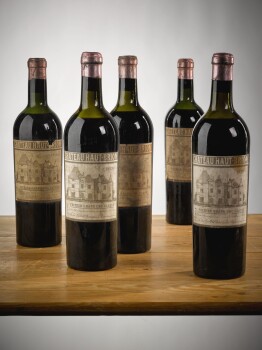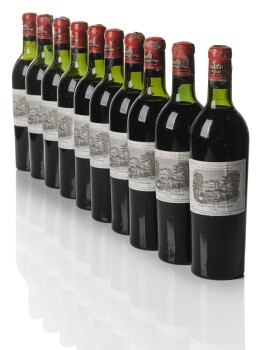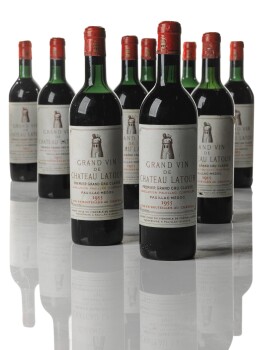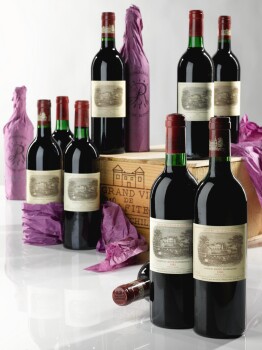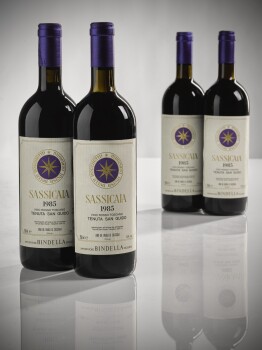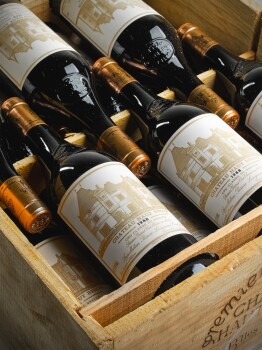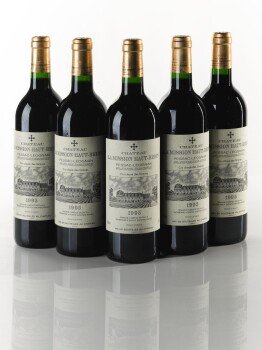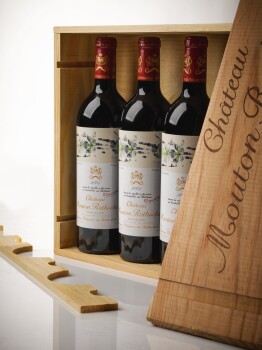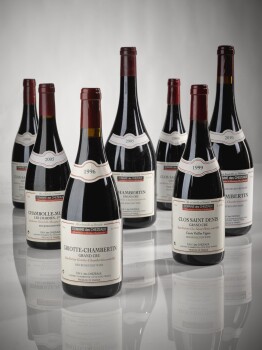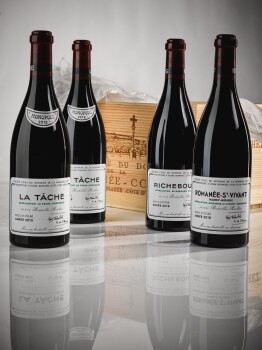S otheby’s is pleased to announce our inaugural London online wine auction, Vine | The Cointreau Collection + More, now open for bidding.
This auction is a marvellous display of vinous pyrotechnics that provides excitement and stimulation, with cases, bottles and large formats from many of France’s greatest vineyards and most starry vintages. There are wines to lay down for deserving children and mature gems for the buyer to drink himself – or herself, which is just as important. A major consignor here, Beatrice Cointreau, would certainly agree that wine is for all, as she was brought up in a family where she was encouraged to appreciate, and collect, fine wine and we are fortunate to bring her well-chosen treasures to our world-wide clients. The First Growths from the decade of the Fifties are impressive, and tempting, but the net is spread wide throughout Bordeaux, running through the Nineties to 2000, 2005 and 2009. To toast this fine array, there is delicious Champagne, very much a part of Beatrice Cointreau’s professional life.
Bedrock Bordeaux vies with Burgundian jewels throughout this sale, all classics of their genre. There is plenty of Claret for those who want an immediate experience, but this is also a splendid opportunity to acquire those twin greats 2009 and 2010, hardly identical twins as they are so stylistically different, although both are at the top of the quality ladder. With even longer potential, this is one of the first occasions where significant quantities of the highly vaunted 2016 vintage are available and they are from some of the most admired properties in Bordeaux, from both Right and Left Banks – we are often challenged to taste blind but, here, you could buy blind! And, for me, the mouth-watering selection of 2005s is a real magnet. This wonderfully chosen line-up brings back memories of tasting this vintage ‘en primeur’, when its magnificent attack and character, breed and sheer impact, were ultra evident from the start. I am sometimes drawn in to broaching a 2005 at this high level and, although one feels a twinge of guilt as these are clearly textbook keepers, it is always a fantastic experience.
Burgundy lovers are advised to jump in quickly as here we are in ‘allocation territory’, where it is maddeningly difficult to acquire wines from the most vaunted growers and Grands Crus from the grandest appellations, both of which exist in tantalising small quantities that have to satisfy demand that is exponential. The Domaine du Comte Liger-Belair is just one example, while the Griotte Chambertin of Domaine des Chézeaux is not, shall we say, readily available. Please go through this listing with a very fine comb.
The final ‘bonne bouche’ are the Kistler Chardonnays, the single clone Chardonnay experts who make these beautiful, creamy, balanced wines from eleven different vineyard sites. All are here. If you yearn for top white Burgundy, but wish to spread your wings, this is where you should fly.
Serena Sutcliffe, MW

W ith a family tree dating back to 1270 in South West France, where for centuries the greatest Loire Valley and Bordeaux wines have been produced, my life has always been happily entwined with wine. In the 16th century, one of our ancestors, the famous Renaissance Writer and Humanist François Rabelais (in a poem called “la Dive Bouteille” a calligram, where the words on the page form the shape of a bottle) sang the praises of a divine bottle “whose mysterious deep does ten thousand secrets keep”, full of “Wine that mounts us to the skies”. His novels inspired a way of life where wine helped to build bridges between people, with happy memories of sharing and celebration.

Closer to me, both grandfathers were wine collectors and entertained with many amazing bottles. On my mother’s side, André Renaud, founder of Rémy Martin and on my father’s side, André Cointreau. My father, Max, continued the tradition, setting up his own collection and encouraging me to do so as well. My father helped me develop my palate, allowing me to sample his amazing wines at special celebrations and taught me how to collect and nurture these beautiful bottles. Amongst 7 ‘epicurean’ children, I am the only one who graduated and certified in wine, from both Bordeaux, France and UC Davis, California. Wine is my passion and my life. Thanks to 30 years of experience as a Cognac and Champagne producer together as a member of both “The Wine Academy of France” and “The Women of the Vine and Spirits foundation”, I have had the opportunity to develop strong friendships among my peers in the world of wine who have shared with me many stories behind each vintage.

I have enjoyed collecting all these châteaux with respect and appetite, carefully keeping the bottles in my cellar, opening a case of each, over the years. It has been my pleasure to share these tastings with the new generation, building their own knowledge and respect for these exceptional terroirs, a combination of the best climate, soil and know-how. Today it is an honour to pass on these gems. We are writing history throughout the years, centuries and beyond. These bottles are history and meant to be shared.
Enjoy!
Béatrice Cointreau
All the wines were purchased through established wine merchants, the majority being packed in original wooden cases which were opened for the first time by Sotheby’s Specialists. These wines have been stored in a deep underground cellar with natural constant temperature and humidity. The rare selection of First Growths from the legendary 1952, 1953 and 1955 vintages were purchased at Quien & Cie en primeur. Packed in their original wooden cases with a few traces of woodworm, the cases were heat treated for this sale.
- 1928
- 1953
- 1955
- 1982
- 1985
- 1988
- 1995
- 2005
- 1999
- 2015
-
 Château Haut Brion 1928This has always been a wine to cause comment, seemingly super-extracted and sweet. In 2014, it was all toffee and raisins, with high volatile acidity that makes it seem almost ageless. A conundrum, but a riveting one.
Château Haut Brion 1928This has always been a wine to cause comment, seemingly super-extracted and sweet. In 2014, it was all toffee and raisins, with high volatile acidity that makes it seem almost ageless. A conundrum, but a riveting one.
Serena Sutcliffe, MW
View Lot -
 Château Lafite 1953I have had many perfectly delicious bottles of this, with textbook Lafite beauty and harmony, delicacy of flavour and the true trademark long finish. It is getting older, of course, and my last bottle in 2009 was all sweetness and cinnamon, but beginning to dry up. As usual, with wines of this age, every bottle is different, enhanced by the variation in provenance, as one would expect.
Château Lafite 1953I have had many perfectly delicious bottles of this, with textbook Lafite beauty and harmony, delicacy of flavour and the true trademark long finish. It is getting older, of course, and my last bottle in 2009 was all sweetness and cinnamon, but beginning to dry up. As usual, with wines of this age, every bottle is different, enhanced by the variation in provenance, as one would expect.
Serena Sutcliffe, MW
View Lot -
 Château Latour 1955The nose of a great vintage and this is right at the top. Rich, spicy and classy. Rolls round the mouth in leathery, cedary glory, with an opulent, thick texture and, on the evidence of this bottle, no volatile acidity. Tremendous.
Château Latour 1955The nose of a great vintage and this is right at the top. Rich, spicy and classy. Rolls round the mouth in leathery, cedary glory, with an opulent, thick texture and, on the evidence of this bottle, no volatile acidity. Tremendous.
Serena Sutcliffe, MW
View Lot -
 Château Lafite 198265% Cabernet Sauvignon in this vintage. On Christmas Eve 2013, an incredibly rich, spicy, leathery nose, multi-layered and meaty. The taste balances fresh acidity with real maturity and it is just so "thick" and velvety. Enormous tannic structure with irony backbone.
Château Lafite 198265% Cabernet Sauvignon in this vintage. On Christmas Eve 2013, an incredibly rich, spicy, leathery nose, multi-layered and meaty. The taste balances fresh acidity with real maturity and it is just so "thick" and velvety. Enormous tannic structure with irony backbone.
Serena Sutcliffe, MW
View Lot -
 Sassicaia 1985Miraculous wine is the product of extremely warm, dry weather, but similar weather now would not result in such a balanced wine - the alcohol would surely have been much higher. Despite the low yields in 1985, the alcohol is perfectly normal. Beautifully healthy, lustrous nose imbued with great red fruit freshness - and this is at its quarter century! Plums and redcurrants. Such finesse of texture. Lovely gummy flavour, with liquorice, vanilla pod and a touch of menthol. Just so true all the way through, with a glorious finish of toast and mixed fruit jam. The persistence of flavour is amazing. All the plaudits are more than deserved.
Sassicaia 1985Miraculous wine is the product of extremely warm, dry weather, but similar weather now would not result in such a balanced wine - the alcohol would surely have been much higher. Despite the low yields in 1985, the alcohol is perfectly normal. Beautifully healthy, lustrous nose imbued with great red fruit freshness - and this is at its quarter century! Plums and redcurrants. Such finesse of texture. Lovely gummy flavour, with liquorice, vanilla pod and a touch of menthol. Just so true all the way through, with a glorious finish of toast and mixed fruit jam. The persistence of flavour is amazing. All the plaudits are more than deserved.
Serena Sutcliffe, MW
View Lot -
 Château Haut Brion 1988Extraordinarily spicy, minerally, Havana nose, with deep spicy plums. The extra acidity projects the bouquet in an amazing way. Stunning flavour on the palate. Deep black wine. Minerally and earthy. Sweet finish plus leather and iron. This is a great buy.
Château Haut Brion 1988Extraordinarily spicy, minerally, Havana nose, with deep spicy plums. The extra acidity projects the bouquet in an amazing way. Stunning flavour on the palate. Deep black wine. Minerally and earthy. Sweet finish plus leather and iron. This is a great buy.
Serena Sutcliffe, MW
View Lot -
 Château La Mission Haut Brion 1995Last tasted in 2012 where it really shone with vibrant character and inky, irony splendour. So much verve and splendid black fruit, designed for a long life if we only let it!
Château La Mission Haut Brion 1995Last tasted in 2012 where it really shone with vibrant character and inky, irony splendour. So much verve and splendid black fruit, designed for a long life if we only let it!
Serena Sutcliffe, MW
View Lot -
 Château Mouton Rothschild 200585% Cabernet Sauvignon, 14% Merlot, 1% Cabernet Franc. In 2019, this is spectacular, fresh and with a huge life ahead, but already ultra enjoyable to taste, in that ripe cassis way. Great structure and harmony, developing all the dimensions almost as one drinks - as one does.
Château Mouton Rothschild 200585% Cabernet Sauvignon, 14% Merlot, 1% Cabernet Franc. In 2019, this is spectacular, fresh and with a huge life ahead, but already ultra enjoyable to taste, in that ripe cassis way. Great structure and harmony, developing all the dimensions almost as one drinks - as one does.
Serena Sutcliffe, MW
View Lot -
 Clos St. Denis, Cuvée Vieilles Vignes 1999, Domaine des ChézeauxDeeply coloured cherry red, right to the rim. The nose has good depth with a laser-like focus of black cherry running through the middle, dried fruits also in evidence. Superb intensity on the palate – this is special. The fruit just keeps on going through the achingly long finish. Perfect acidity and tannins that you hardly notice – buy every bottle that you can find!
Clos St. Denis, Cuvée Vieilles Vignes 1999, Domaine des ChézeauxDeeply coloured cherry red, right to the rim. The nose has good depth with a laser-like focus of black cherry running through the middle, dried fruits also in evidence. Superb intensity on the palate – this is special. The fruit just keeps on going through the achingly long finish. Perfect acidity and tannins that you hardly notice – buy every bottle that you can find!
Bill Nanson
View Lot -
 La Tâche 2015, Domaine de la Romanée-ContiAverage age of vines, 50 years. 25.55 hl/ha made. In 2018, a 'silky' nose of real breed, with an all-invasive perfume that is very slightly 'Asian'. The feel in the mouth is noble, with notes of violets and vanillin and a 'sweetness' that is totally seductive. It just 'never dies', snowballing the dimension and depth as the seconds pass. Formidable.
La Tâche 2015, Domaine de la Romanée-ContiAverage age of vines, 50 years. 25.55 hl/ha made. In 2018, a 'silky' nose of real breed, with an all-invasive perfume that is very slightly 'Asian'. The feel in the mouth is noble, with notes of violets and vanillin and a 'sweetness' that is totally seductive. It just 'never dies', snowballing the dimension and depth as the seconds pass. Formidable.
Serena Sutcliffe, MW
View Lot

D omaine des Chézeaux is one of the less well-known domaines in Burgundy but dig a little under the surface and there are some real gems to find here.
Formed in 1982 from the holdings of the Mercier family who have held the vineyards since 1928 and still run the company (SNV des Chézeaux). The name ‘Chézeaux’ refers to the original Mercier family home close to the Chateau of Gevrey within the walls of which are about half a hectare of vines – Clos de Chézeaux. The Domaine des Chézeaux owns almost 60% of Griotte-Chambertin, the smallest of the 9 Gevrey Grand Crus.

With no winemakers in the family, their holdings are all ‘en metayage’ i.e. they are ‘farmed’ by others (Ponsot, Leclerc & Berthaut) who take two thirds of the crop as payment, the balance going to ‘des Chézeaux’.
Ponsot is metayeur of the Mercier's Chambertin, Clos St.Denis, Chambolle 1er Charmes and the larger of their two parcels of Griotte-Chambertin - nearly a hectare. René Leclerc only has Griotte from the Mercier family (Domaine des Chézeaux). Examples from each can be found in this sale.
The Ponsot wines here, including his virtually unobtainable Clos St. Denis Très Vieilles Vignes, are identical to his own wines. Clos St. Denis is planted on a clay-limestone soil with a mixture of iron oxide and sits between Clos de la Roche to the north and Clos des Lambrays to the south. The vines here were planted in 1905 and from 2005 Ponsot has used the term Très Vieilles Vignes on his own labels and on the corks of des Chézeaux, although the Merciers continue to use Vieilles Vignes on their own labels. Ponsot’s Clos St. Denis shares many of the qualities of his Clos de la Roche; Concentration, structure and incredible length but perhaps a little less power, more finesse and charm and tends to be approachable earlier on in its development.
These are magical wines and their story always provokes fascinating conversation around the dinner table.

T hroughout the centuries, Lafite has proved that this is a wine that ages in the most ethereal way. Lafite combines elegance, breed and scent with sustained power, a miracle of balance and nobility. The extraordinary terroir and position in Pauillac have always been matched by the Rothschilds' sense of quality and vision, resulting in a wine that has mythical status. Continuity is vital in producing a great wine and the wine-making brilliance of Charles Chevallier from the 1990s to early 2016 has added extra lustre to this exceptional liquid, with the fame of the property spreading further throughout the world. When serving Lafite, decant it well in advance of drinking as its bouquet and taste amplify to multi-faceted dimensions on contact with the air. At the Château itself, they double decant, back into the original bottle with its unchanging, instantly recognisable label. Lafite matures slowly, developing gloriously with bottle age, as historic tastings have shown. Collect Lafite for yourself and watch it grow!
Serena Sutcliffe, MW










